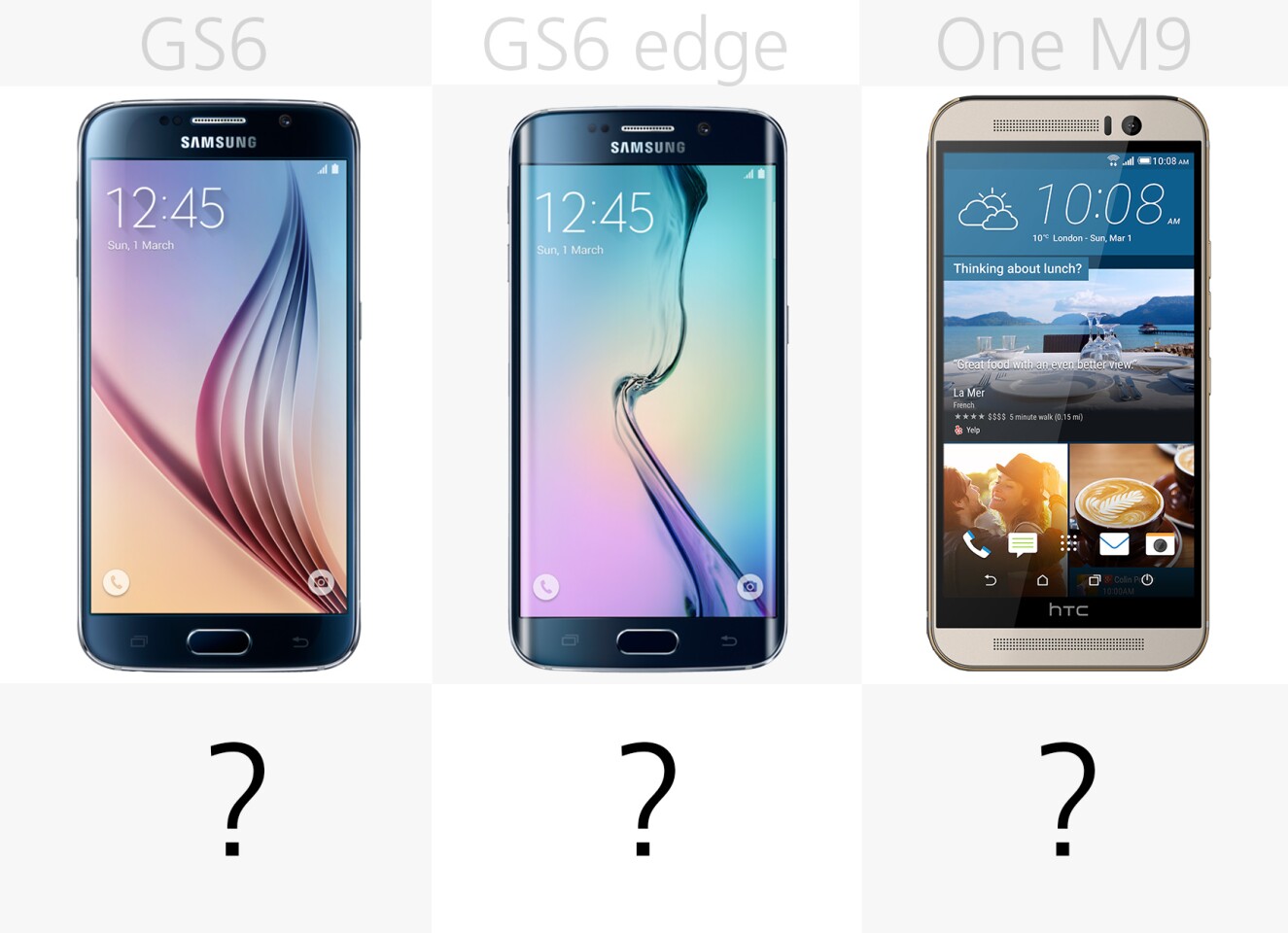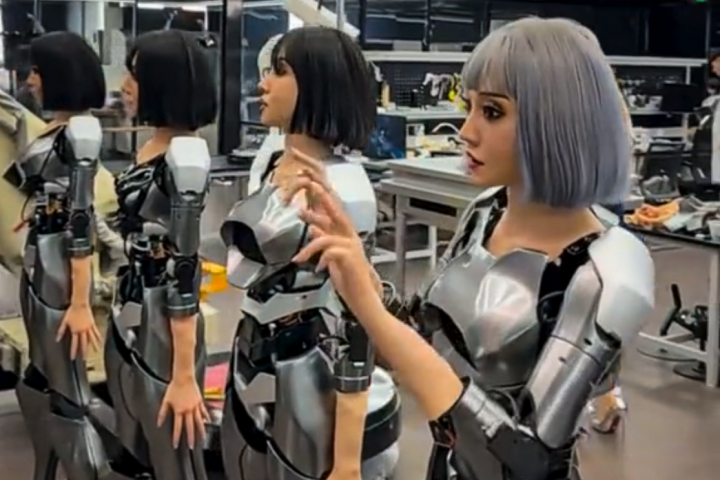Samsung and HTC have each been launching their flagships at around the same time for the last few years, making Galaxy vs. One dilemmas an annual occurrence for smartphone shoppers. This year, though, Samsung is making it harder for HTC to keep up, as the Galaxy S6 and Galaxy S6 edge leap forward much farther than the HTC One M9 does. Let's compare the three phones' features and specs.
Size

No major differences in the sizes of their faces (though the One M9 is a little taller than the Galaxies), but thickness is a different ballgame. Compared to the HTC One M9, the Samsung Galaxy S6 is 29 percent thinner and the Galaxy S6 edge is 27 percent thinner.
Weight

It's clear that HTC isn't winning any light/thin prizes this year. The One M9 is 14 percent heavier than the Galaxy S6 and 19 percent heavier than the Galaxy S6 Edge.
Build (back)

Plastic begone! Samsung is going high-end with this year's flagships, starting with the glass (Gorilla Glass 4) backs on the GS6 and GS6 edge.
Premium builds have always been integral to the HTC One lineup, and this year is no exception. Its aluminum unibody design is no less stunning than in years past, but it's also hard to get too excited about a design that has only incrementally evolved since 2013.
Build (sides)

The Samsung phones also have aluminum frames.
Colors

We're looking at four color options for each handset.
Display (size)

The Galaxy S6 phones also win on screen size, giving you about 4 percent more real estate than the One M9.
Navigation buttons location

Samsung's screen size advantage is a little bigger than that last category would suggest, as the One M9 uses up a bottom row for virtual navigation buttons (Samsung's buttons are physical and capacitive, sitting below its screen).
The only asterisk is that in places like video, e-reading and photo apps, Android's Immersive Mode will fade out the M9's navigation keys, letting you (temporarily) use its full 5 inches.
Display (resolution)

Here's another big advantage for the Galaxy S6 and Galaxy S6 edge, as HTC stuck with very sharp, but not as ultra-sharp as Quad HD Full HD resolution.
Display (type)

As in years past, the Samsung phones have Super AMOLED displays (richer colors, greater contrasts and deeper blacks) while the One M9 uses an IPS panel.
Curved display

The GS6 edge continues what Samsung started with 2014's Galaxy Note Edge, sloping its screen off on either side. It's largely a cosmetic feature, but can also flash notifications and shortcuts.
Fingerprint sensor

The fingerprint sensors found in Samsung's 2014 devices were nice bonuses, but could also be a little clunky, as they required you to swipe your finger over them every time. The GS6es' sensors, though, are more like Apple's Touch ID, letting you simply rest your finger on the home button.
Battery

These capacities alone don't necessarily tell you much, so we'll have to wait for our full reviews to have much to say about battery life.
Removable battery

For the first time, a Samsung flagship has a sealed-tight battery. This is nothing new for the HTC One line.
Ultra/Extreme Power Saving Mode

Like last year, both sets of flagships have either Ultra Power Saving Mode (Samsung) or Extreme Power Saving Mode (HTC), which keep you on the grid if you're caught with an almost-dead battery and no charger (by limiting available apps and giving you a simplified home screen with only basic functions).
Fast charging

Both phones also have fast charging systems in place, so you can juice up a low battery faster than you might expect.
Storage

The Galaxy phones each give you three storage options, but the One M9 is only coming in a 32 GB flavor.
MicroSD

Another first for Samsung: neither Galaxy S6 phone has a microSD card slot. The One M9 does let you pop one in to expand its 32 GB internal storage.
RAM

Nothing to worry about here, as all three phones give you an impressive 3 GB of RAM.
Processor

Samsung is kissing Qualcomm goodbye, and switching to its own Exynos processors (now even in LTE regions) for the Galaxy S6 and edge. Our performance impressions will need to wait for review units, but all three should be very fast.
Camera megapixels (rear)

HTC changed its tune this year and is now playing the megapixel game. Its original thinking, that pixel size matters more than pixel count, wasn't completely off base ... but its older Ultrapixel cameras, despite being good in low-lit conditions, weren't good for zooming or cropping.
Camera megapixels (front)

The Ultrapixel camera does live on, however, in the One M9's front-facing shooter.
Camera aperture

The Samsung phones have the wider apertures.
Heart rate sensor

Samsung's 2015 phones may have axed the Galaxy S5's water resistance, but they kept its heart rate sensor (located on the phones' backsides).
Gear VR

HTC has a virtual reality headset coming too, but it has nothing to do with the One M9. Samsung's excellent Gear VR, though, is compatible with the two Galaxy S6 phones. Just be sure to buy the new version, not the original that only fits the Note 4.
Software

All three run Android 5.0 Lollipop at their core, while Samsung's use the TouchWiz UI (a much more scaled-down version this year) and the One M9 has the HTC Sense 7 UI. We'll have more to say about the UIs once we review these three.
Release

The One M9 launches in Taiwan later this month, though we still don't know an exact US release date. The Galaxy S6 pair will be launching on April 10.
Starting price

Previous year versions of Galaxy and One flagships rang up starting at US$650 full retail, or $200 on-contract. We don't yet know for sure if that's what we're looking at here.
You can, however, expect the Galaxy S6 edge to ring up for more than the GS6. Let's just hope the curved-screen markup isn't as high as it was on the Note Edge (an extra $90-190 full retail or an extra $100 on-contract).
For more, you can read Gizmag's full reviews of the Galaxy S6, Galaxy S6 edge and HTC One M9.































